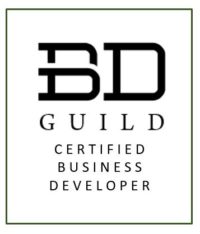 The BD Guild has a lot of support from executive leaders who have been seller doers and business developers longer than I have been alive! In Module 5, both portions were delivered from presenters who returned from the first year BD Guild curriculum with an updated session on both leadership style and how the money is made in construction. Understanding how you impact your company’s bottom line, as well as learning your leadership style, are two critical paths of understanding for an AEC business developer. The construction circle of life was really informative. It begins with business development and identification of a project. Once the opportunity is identified, preconstruction springs into action. The session’s instructors, Craig Bergstrom of UEB Builders and Justin Page of DPA Architects, agreed that “preconstruction is an art, not a science”, and a contractor has to know how their preconstruction model in itself is competitive against the other guys out there. Moving through preconstruction then leads to identifying subcontractors that best align with the scope and client, crosses the legal phase and developing a winning contract with fair terms, and allocating PM’s and Supers that will be responsible for communicating with the client and architect. With on time project delivery and every step prior in good standing, the life cycle ends with a developed reputation and begins again with the identification of a new opportunity.
The BD Guild has a lot of support from executive leaders who have been seller doers and business developers longer than I have been alive! In Module 5, both portions were delivered from presenters who returned from the first year BD Guild curriculum with an updated session on both leadership style and how the money is made in construction. Understanding how you impact your company’s bottom line, as well as learning your leadership style, are two critical paths of understanding for an AEC business developer. The construction circle of life was really informative. It begins with business development and identification of a project. Once the opportunity is identified, preconstruction springs into action. The session’s instructors, Craig Bergstrom of UEB Builders and Justin Page of DPA Architects, agreed that “preconstruction is an art, not a science”, and a contractor has to know how their preconstruction model in itself is competitive against the other guys out there. Moving through preconstruction then leads to identifying subcontractors that best align with the scope and client, crosses the legal phase and developing a winning contract with fair terms, and allocating PM’s and Supers that will be responsible for communicating with the client and architect. With on time project delivery and every step prior in good standing, the life cycle ends with a developed reputation and begins again with the identification of a new opportunity.
Craig mentioned that 80% of the project’s profitability relies on effective preconstruction. It’s advantageous to bring subs in early to consult on cost saving measures that can lose effectiveness the shorter the schedule gets. With plenty of time for value adds, collaboration, and research into other options that benefit the client, by the time it gets to bidding “the cake is in the oven”. It was illustrated how easy it is to quantify business development efforts, and the success of your efforts, by how often potential clients ask for two things: either to come meet them or to submit a quote. If they are asking for your company to come meet them, it’s safe to say they are legitimately interested in your service, already desiring to utilize you, and just need verification and confirmation on it being a good decision. Above all, education and mentorship is valued. You have more opportunities than you can even fathom to educate the client on things they don’t know about construction. Both Craig and Justin did a great job illustrating the ways you can educate the client on how you will bring a positive impact to the project, even consulting them on the most advantageous project delivery method from the conceptual beginning. They also covered how retention works, as well as the delicate issue of never being able to bill for preconstruction, even though the risk of doing a lot of work for no reward is always there. An overall message that resonated with me was that everything you do is an investment with correlated costs, even if the investment is education and lessons learned that didn’t result in a conventional win. What is best for the client prevails overall, so understanding all contract language is important when it comes to lump sum contracting vs GMP contracting.
Rebecca Timmer, Business Development at Dibble Engineering, facilitated the second portion of Module 5, helping the class learn about their strengths through the Clifton Strengths Finder assessment. This premium interactive program usually costs money to buy the book, take the test, and undercover additional assessment details, however this was provided at no cost to BD Guild CBD students. Rebecca helped us understand the key elements of each student’s strengths uncovered in the test, and leadership activities that are highly in line with those personality types. The four main areas of the test assessed our strengths, talents, skills, and knowledge, and the results were compounded into a detailed report. This module really went deep with both technical information on construction profitability as well as building on a business developer’s emotional intelligence through uncovering key strengths.